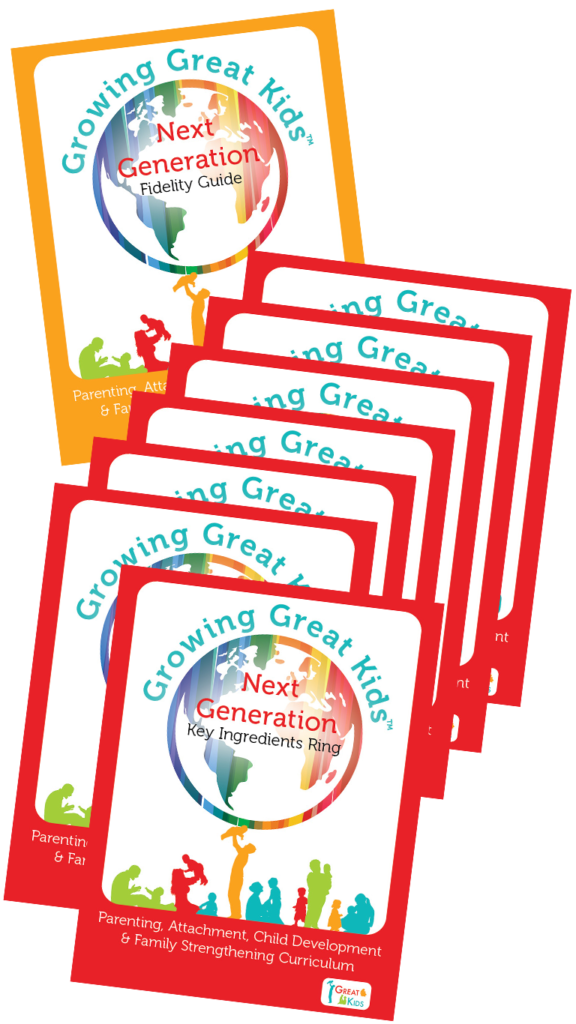For many decades we’ve known that poverty can have a negative impact on child development. The existence of federally funded programs like Head Start and Early Head Start is a testament to the fact that even our legislature understands this at some level. Recently, however, research has led to evidence that the direct relationship between income and brain structure is very large and seen very early in development (Blair, 2016). Today we will discuss some specific results of these recent studies, how caregiving can impact these outcomes, and how the Growing Great Kids and Growing Great Families curricula can help you as you support families in their efforts to overcome the effects of poverty in their child’s development.
Research tells us that the effects of poverty on brain development are seen as early as infancy and the children in low income families have brain volumes that are nearly half a standard deviation smaller than those not living in poverty (Hanson, Hair, & Shen, 2013). These differences were found to be the most pronounced in the parts of the brain that are responsible for executive functioning (Lawson, Duda, & Avants, 2013). Before we move on to discuss what can be done about this, let’s first see if we can get some understanding about what causes the situation, from a neurobiological model.
Early research on child development would lead us to believe that it was all about the reduced opportunities for learning that children living in poverty have. As more disciplines come together to study this, however, it becomes clear that in addition to the reduction in positive stimulation, poverty is also characterized by a lot of other stimulation that actually negatively impacts brain development (Blair, 2016).
“The presence of chronic stressors such as noise, including background noise like that associated with ongoing and unmonitored television, household chaos, and conflict among family members” can adversely impact the brain (Coley, Lynch, & Kull, 2015). These kinds of chronic stressors early in life lead to an overabundance of stress related hormones. Excessive stress hormones are toxic to the developing brain and result in a whole host of negative cognitive, emotional, and behavioral consequences (McEwen & Gianaros, 2010). Chronic stress also alters neural activity in the brain, establishing responses that cause the developing child to become more reactive and defensive (Loman & Gunnar, 2010).
Contributing to this perfect storm, we must also consider the idea that often, when parents are faced with stressful conditions within the home, they are at greater risk for lack of warmth and sensitivity in caregiving. This possible lower parental sensitivity can increase the likelihood that children will have elevated cortisol levels. Elevated cortisol can lead to changes in the brain that cause difficulty regulating emotion and behavior (Evans, Gonnella, Marcynyszyn, Gentile, & Salpekar, 2005). When you combine all of these pathways, we begin to understand why we see wide disparity in school readiness and achievement, and positive life outcomes (Blair, 2016).
Let’s think for a minute though about the fact that some families are able to maintain high levels of nurturing care for their children despite the struggles of poverty. When this happens, the responsive caregiving acts as a protective buffer for the child’s developing brain. Growing these kinds of resilient families is a common goal for both Great Kids Inc. and most of the programs using the GGK and GGF curricula. Let’s take a look at some of the resources within the curricula for supporting the kinds of positive parenting behavior that can have a huge impact on the developing brains of children living in poverty.
There would probably be justification for listing almost everything that is included in GGK and GGF, as it is all designed specifically to target exactly the kinds of threats to the developing brain that research has identified. That all-inclusive list, however, would probably be less then helpful. Instead we’ll look at a few specific modules that are focused on helping parents understand the critical nature of their parenting behavior in growing a resilient child. When they begin to understand why they are so important in the development of their child’s brain, the how will become much easier for them.
All of the Daily Do’s, of course, will be important for this process, as well as Getting in Sync and Ready for Play. All of the Social and Emotional, Physical and Brain, and Play and Stimulation modules in each unit of each manual also apply here. These won’t be listed repeatedly, but be sure to include them in planning home visits. In addition, you will want to pay particular attention to the following sections:
Prenatal Manual
Unit 1: Program and Home Visiting Orientation
Module 1 – Subsection: Why Early Childhood Matters
Unit 2: Prenatal Attachments for Moms and Dads
Module 1 – Subsection: Cultivating Attachment – Everything your Baby will Ever Need
Module 2: Prenatal Attachment: Growing Bonds of Love
Module 5: Parenting to Grow a Resilient Child
Unit 3: Pregnancy and the Developing Brain
Module 4: Your Baby’s Developing Brain
Unit 4: Family Enhancements
Module 1: Becoming a Parent…Becoming a Family
Module 2: Power Down Stress…Power Up Happiness
Birth to 12 Month Manual
Getting Acquainted Unit
Module 1: Attachment, Bonding and Caring for Your New Family
Subsection: Protecting and Loving Your Baby
0-3 Months Unit
Module 3: Cues and Communications
7-9 Months Unit
Module 3: Cues and Communication – Subsection: Babies Respond to Their Family’s Emotions
13-24 Months Manual
13-15 Month Unit
Module 3 Cues and Communication – Subsection Yelling Can Toddlers Listen?
16-18 Months Unit
Module 1 Basic Care – Subsection Balancing Toddlers Needs
19-21 Months Unit
Module 3 Cues and Communication – Subsection: Whining/Screaming, Biting , and Hitting
Growing Great Families Manual
Unit 1: Strengthening Family Foundations and Motivating Growth
Module 2: Shaping Your Child’s Future
Module 3: Learning About Family Values and Strengths
Unit 2: Reducing Stress
Module 1: Protecting Your Child from Toxic Stress
Module 5: Warning Signs for Stress Overload
Module 6: Communicating Effectively
Module 8: Problem Talk
Module 9: Growing Your Support Network
Unit 3: Discipline and Special Parenting Circumstances
Module 1-3 Discipline
Module 9: Supporting Your Child’s Development
Unit 4: Blueprints for Emergent Use
Blueprint 2: Supporting Goal Success
Blueprint 3: Reconnecting Parents to their Children’s Needs During Times of Stress
The struggles of poverty are vast and very real. They can’t be righted with just one simple solution, it requires a multi-pronged approach in which we each play a role. During an initial interview with a family seeking services, one four year old little girl spent most of the time drawing pictures while her mom talked with the worker. As they were walking out the door, the child turned and asked “Are you really going to help us?” (Benfer & Walsh, 2016)
Out of the mouth of this little girl came the real question that we are all called to ask ourselves everyday…are we really going to help…and even further…how are we going to do that? The brain is where all thought and emotion originates. Assuring that each child’s brain is provided with everything that it needs to develop to its full potential is at the very heart of the work we do. As individuals and as a society, we need to use all the tools we have at our disposal to protect the brain development of our children.
Works Cited
Blair, C. (2016). Poverty, stress, and brain development: New directions for prevention and intervention. Academic Pediatrics, S30-S36.
Coley, R., Lynch, A., & Kull, M. (2015). Early exposure to environmental chaos and children’s physical and mental health. Early Childhood Research Quarterly, 94-104.
Evans, G., Gonnella, C., Marcynyszyn, L. A., Gentile, L., & Salpekar, N. (2005). The role of chaos in poverty and children’s socioemotional adjustment. Psychological Science, 560-565.
Hanson, J., Hair, N., & Shen, D. (2013). Family poverty affects the rate of human infant brain growth. PLOS One, e0146434.
Lawson, G., Duda, J., & Avants, B. (2013). Associations between children’s socioeconomic status and prefrontal cortical thickness. Developmental Science, 641-652.
Loman, M., & Gunnar, M. (2010). Early experience and the development of stress reactivity and regulation in children. Neuroscience and Biobehavioral Reviews, 867-876.
McEwen, B., & Gianaros, P. (2010). Central role of the brain in stress and adaptation: links to socioeconomic status, health, and disease. Annals of the New York Academy of Sciences, 190-222.
As always, feel free to email any topic suggestions or questions to danabroadway@greatkidsinc.net . Be sure to add Great Vine ideas to the subject line of the email.

